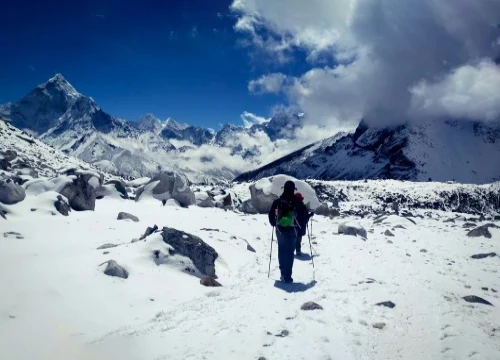A Brief History of the Annapurna Circuit and Thorong La Pass
The journey along the Annapurna Circuit, with its dramatic landscapes and cultural experiences, officially opened its doors to foreign trekkers in 1977. Until that time, the region was closed off to international visitors because of political and security concerns. The initial trekking route began in the bustling market town of Dhumre, located on the Kathmandu-Pokhara highway, and concluded in Pokhara. Trekkers undertaking this historic route usually spent approximately 23 days navigating the region’s diverse terrain, high mountain passes, deep valleys, and local villages.
The opening of the route heralded a new era in adventure tourism for Nepal, creating opportunities for global trekkers to witness the natural beauty and cultural diversity of the Himalayas. However, the same challenging conditions that make the Annapurna Circuit so alluring also contribute to its inherent risks, as evidenced by several historical tragedies.
The 2014 Cyclone at Annapurna circuit: 43 deaths happened October
The biggest disaster during trekking on Nepal happened during 14th of October at Annapurna circuit when a cyclone merged and brought a Among the many incidents that have marred the history of the Annapurna Circuit, the single most catastrophic event occurred on October 14, 2014. On this day, a sudden and ruthless blizzard struck the heart of the Annapurna region, placing the Thorong La Pass—which stands at an elevation of 5,416 meters—directly in the storm’s path.
Meteorological Conditions and the Blizzard's Onset
This severe weather event was the result of an extraordinary meteorological convergence. Remnants of Cyclone Hudhud merged with an upper-level trough, creating an environment capable of generating an extreme snowstorm. In a mere 12 hours, parts of the trail were blanketed with nearly 1.8 meters (almost 6 feet) of snow, a volume of snowfall that dramatically altered the landscape and presented a sudden, life-threatening challenge to everyone caught in its path.
The Human Toll
The impact of the blizzard was both swift and devastating. Official reports confirmed that at least 43 individuals lost their lives during this disaster. The fatalities included a mix of international trekkers—originating from diverse nations such as Nepal, Israel, Canada, India, Slovakia, and Poland—in addition to local guides, porters, and support personnel. Beyond the tragic loss of life, approximately 175 people sustained injuries, with many facing severe conditions like frostbite and hypothermia. Moreover, estimates suggest that between 10 and 50 trekkers were never found, remaining missing in the aftermath of the chaos.
Rescue Operations Amid Extreme Conditions
The blizzard not only claimed lives but also severely disrupted essential services in the region. Communication channels, electrical power, mobile networks, and internet services were all overwhelmed by the sudden deluge of snow and harsh cold conditions, particularly in the Manang District.
Rescue efforts had to be mounted under exceedingly dangerous circumstances. Over 70 helicopter sorties were executed by the Nepali Army and civilian agencies, highlighting one of the largest-ever rescue missions in the high Himalayas. By the time operations finally wound down around October 19, 2014, an estimated total of 518 people had been evacuated from critical locations including Thorong La, Manang, Mustang, and the Tukuche base camp.
Detailed Impact Analysis of the 2014 Disaster
Fatalities and Human Loss
- Total Fatalities: At least 43 people lost their lives, a grim reminder of how quickly nature’s fury can claim lives.
- International and Local Victims: The deceased included international trekkers from various nations and local community members such as guides, porters, and yak herders.
Injuries and Missing Persons
- Injuries Reported: Approximately 175 trekkers suffered from various degrees of injury. Many of these injuries were a result of severe frostbite and life-threatening hypothermia.
- Missing Individuals: In the turmoil that ensued after the blizzard, reports indicated that between 10 and 50 trekkers went missing. Their fates remain a poignant reminder of the chaotic conditions on the mountain.
Rescue Challenges
- Communication Breakdown: The extreme weather effectively brought traditional communication methods to a halt.
- Helicopter Deployments: With the vast and rugged terrain becoming nearly impassable, helicopter rescues emerged as the primary method of evacuation. These efforts were complicated by the continued presence of heavy snowfall and low visibility.
- Prolonged Rescue Efforts: It took several days for rescue teams to stabilize the situation and ensure that all survivors were safely evacuated.
Contributing Factors to the Devastation at Thorong La Pass
Understanding why the disaster on October 14, 2014, escalated into one of the deadliest events on Thorong La Pass requires examining several contributing factors:
Sudden Onset of Severe Weather
The rapid development of the snowstorm caught many trekkers off guard. The merging of Cyclone Hudhud’s remnants with an upper-level trough created an unusually severe weather scenario that few expected. This sudden change left little time for trekkers to seek immediate shelter or to retreat to safer areas along the trail.
Inadequate Early Warning Systems
Communication systems and early warning protocols in the region were not fully equipped to handle such extreme conditions. Many trekkers received little to no advance notice about the impending storm, which significantly hampered any efforts at preemptive action.
Insufficient Gear and Acclimatization
A critical factor was the preparedness of the trekkers. Both international travelers and local workers often lacked the appropriate high-altitude gear necessary to survive such extreme conditions. Moreover, many trekkers had not adequately acclimatized to the high altitude, making them more vulnerable to acute mountain illnesses like Acute Mountain Sickness (AMS), High-Altitude Pulmonary Edema (HAPE), and High-Altitude Cerebral Edema (HACE).
The Treacherous Terrain
The Annapurna Circuit, and Thorong La Pass in particular, are characterized by steep, rugged paths that naturally pose significant risks. The sudden and heavy snowfall exacerbated these dangers, increasing the risk of avalanches and making it even more challenging to navigate the narrow trails.
Additional Incidents on Thorong La Pass Over the Past Decade
The 2014 blizzard is the most infamous disaster, but Thorong La Pass has seen other fatal incidents over the years that underscore the perilous nature of high-altitude trekking:
March 2019 Avalanche
In March 2019, an avalanche along the Annapurna Circuit claimed the life of trekking guide Ajay Dhakal, who was just 25 years old and hailed from Dhading district. During the same incident, a Dutch national by the name of Bloem Vincent went missing. Reports indicate that heavy snowfall in the region likely triggered the avalanche, further highlighting the vulnerability of trekkers to sudden weather shifts.
January 2023: The Korean Solo Trekker
In January 2023, a 45-year-old Korean solo trekker was found deceased near Thorong La Pass. It is believed that trekking without the guidance of an experienced local or group significantly increased her risk, especially as she possibly succumbed to high-altitude sickness. This tragic event serves as a stark reminder of the importance of structured trekking in such perilous environments.
June 2024 Altitude Sickness Fatality
In June 2024, another fatality brought to light the dangers of altitude sickness. Hari Adhikari, from Phulkharka in the Dhading district, experienced severe altitude-related symptoms while at Thorong La Pass and tragically died on-site. His death underscored how vital it is for trekkers to acclimatize properly and to carry sufficient gear to manage the challenges of high elevation.
General Altitude Sickness Fatalities (2023–2024)
During the fiscal year 2023–2024, the Annapurna Conservation Area recorded a total of 21 deaths attributed to altitude sickness. Among the deceased, six were Nepali nationals. Most of these incidents occurred in the Muktinath area of Mustang, further emphasizing the persistent risks associated with high-altitude trekking in this region.
Root Causes of Fatalities on the Annapurna Circuit
The Annapurna Circuit continues to report a range of fatal incidents not only because of the extreme weather but also for several underlying reasons that collectively increase the inherent risks of high-altitude trekking:
Altitude-Related Illnesses
- Acute Mountain Sickness (AMS): Many trekkers experience AMS, a condition that can escalate quickly if not managed with adequate rest, proper hydration, and gradual acclimatization.
- High-Altitude Pulmonary Edema (HAPE): This condition occurs when fluid accumulates in the lungs, making breathing extremely difficult at high altitudes.
- High-Altitude Cerebral Edema (HACE): The build-up of fluid in the brain can lead to life-threatening complications.
These conditions illustrate why trekkers must always be vigilant about describing early signs of high-altitude illnesses and why proper acclimatization schedules are critical.
Extreme Weather Conditions
The Annapurna region is notorious for its unpredictable weather. Sudden blizzards—such as the one in 2014—can pack a deadly combination of heavy snowfall, avalanches, and sub-zero temperatures that overwhelm even the most experienced trekkers. The lack of reliable communication and weather forecasting in remote mountain areas exacerbates the risk of being caught unprepared by a rapid storm.
Accidents in a Treacherous Environment
Accidents on the Annapurna Circuit aren’t limited only to weather-related events. The steep and rugged terrain often leads to falls, missteps, and traumatic accidents during descent or navigation of narrow trails. Avalanches triggered by heavy snowfall further heighten the potential for fatal accidents.
Safety Reforms and Preventive Measures After the Disaster
In the wake of the 2014 disaster and subsequent fatal incidents, Nepal’s tourism and trekking authorities have implemented several crucial measures to enhance safety and reduce the risk of similar tragedies in the future.
Enhanced Trekking Registries
Mandatory trekking registries have been established to better account for every visitor. This system not only helps in monitoring the number of trekkers in high-risk areas but also proven invaluable during rescue operations should an emergency arise.
The Use of Licensed Guides
To combat the risks associated with inexperienced trekking, the authorities have mandated the use of licensed and experienced guides. These professionals possess the critical skills required to navigate challenging terrain and manage unexpected emergencies, thereby reducing the risk for trekkers.
Installation of Emergency Shelters
Emergency shelters have been strategically installed along the trekking routes, particularly in high-risk areas like Thorong La Pass. These shelters provide critical refuge in the event of sudden weather changes, giving trekkers time to regroup and seek further assistance.
Improved Weather Forecasting and Communication Systems
One of the most significant reforms has been the upgrade of weather forecasting systems. With improved meteorological monitoring and better communication channels, trekkers now receive more reliable warnings about impending storms and hazardous weather conditions. This has allowed for more timely evacuations and preventive measures.
Criticism and Accountability
In addition to these technical reforms, public and governmental criticism following the disaster has underscored the importance of accountability. Authorities have acknowledged the shortcomings in both the weather alert systems and the methods of communication with trekkers. This collective introspection has led to more stringent measures aimed at preventing future tragedies.
Lessons for Future Trekkers on the Annapurna Circuit
The history of Thorong La Pass is a sobering reminder of both the beauty and danger inherent in high-altitude trekking. For future trekkers, several vital lessons emerge from these events:
- Preparation is Paramount: Ensure that you are equipped with appropriate high-altitude gear and that you follow a strict acclimatization schedule. Do not underestimate the speed at which weather conditions can deteriorate.
- Travel with Experienced Guides: The benefits of trekking with licensed and experienced guides cannot be overstated. Their deep knowledge of the terrain, weather patterns, and emergency procedures can make a life-saving difference.
- Stay Informed: Constantly monitor up-to-date weather forecasts and heed early warning systems. Lack of communication can lead to disastrous outcomes—a lesson clearly learned from the 2014 blizzard.
- Emergency Preparedness: Familiarize yourself with the locations of emergency shelters along the trekking route. Knowing where to retreat in case of sudden adverse weather can significantly increase your safety.
- Respect the Terrain: Recognize that the rugged terrain of the Annapurna Circuit is inherently unpredictable. Exercise caution on steep paths and be aware that even minor missteps can result in serious injury, especially in an environment prone to avalanches.
Conclusion
The legacy of fatal incidents on Thorong La Pass, most notably the 2014 blizzard, is a powerful testament to the unpredictable force of nature. It illustrates that while the beauty of the Annapurna Circuit is undeniable, it also demands respect, careful preparation, and adherence to safety protocols. Since its opening to foreigners in 1977, the Annapurna Circuit has evolved from being solely an adventurous trek to a route that now incorporates advanced safety measures all aimed at protecting both international visitors and local communities.
Enhanced trekking registries, the mandatory use of licensed guides, the installation of emergency shelters, and improvements in weather forecasting systems underscore the lessons learned from past tragedies. These measures not only increase safety but also ensure that future trekkers can enjoy the very best of what Nepal’s high Himalayas have to offer without the looming threat of disaster.
For anyone contemplating trekking on this legendary route, the history of Thorong La Pass serves as both a cautionary tale and an inspiration to approach the adventure with utmost respect for nature. Whether you are an experienced trekker or a first-time adventurer, thorough preparation and vigilance remain the most effective tools in ensuring that your journey through the Annapurna Circuit is as safe as it is unforgettable.
Curious about in-depth safety recommendations for high-altitude trekking gear, acclimatization techniques, or personal stories from survivors of these disasters? The evolving landscape of Himalayan trekking offers a wealth of insights and expert tips that can further prepare you for the challenges and rewards of exploring one of the world’s most dramatic and awe-inspiring mountain regions. With a renewed focus on safety and responsible trekking practices, the Annapurna Circuit continues to be a beacon for adventure while also an enduring symbol of both nature's beauty and its might.







